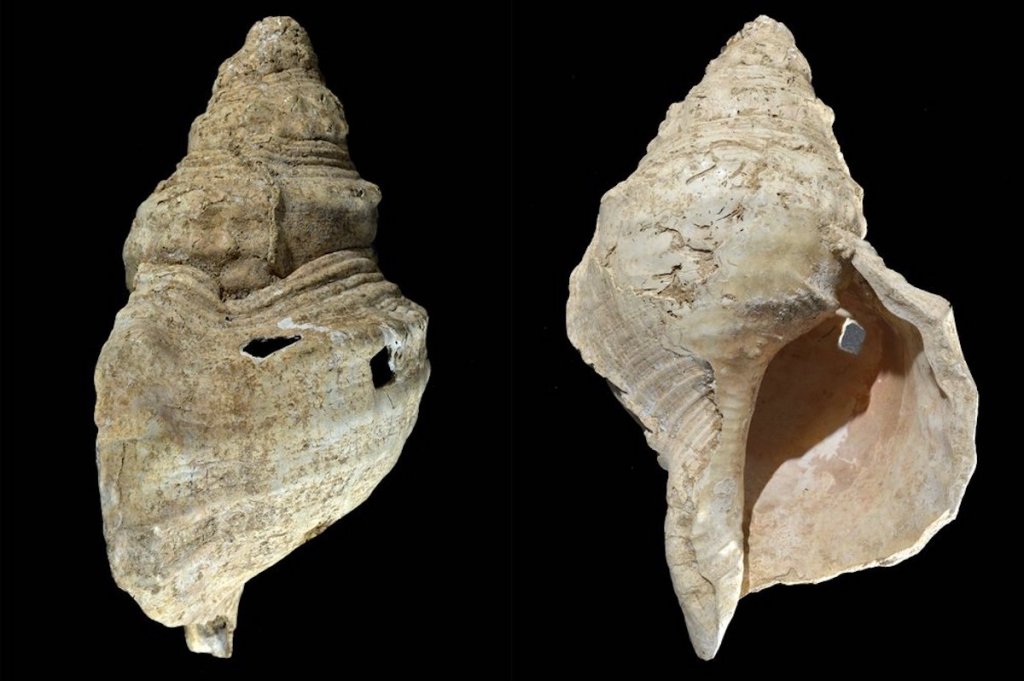News of the Weird
Published 6:00 am Tuesday, February 16, 2021

- This combination of photos in February 2021 shows two sides of a 12-inch conch shell discovered in a French cave with prehistoric wall paintings in 1931. Using modern microscopy techniques to examine how the shell was modified and hiring a French horn player to test it out, researchers found the shell could produce C, C sharp and D notes. Using carbon dating of related artifacts in the cave, researchers estimate the age to be around 18,000 years, making it the world’s oldest seashell instrument known.
Ancient shell horn can still play a tune after 18,000 years
WASHINGTON — A large conch shell overlooked in a museum for decades is now thought to be the oldest known seashell instrument — and it still works, producing a deep, plaintive bleat, like a foghorn from the distant past.
The shell was found during the 1931 excavation of a cave with prehistoric wall paintings in the French Pyrenees and assumed to be a ceremonial drinking cup. Archaeologists from the University of Toulouse recently took a fresh look and determined it had been modified thousands of years ago to serve as a wind instrument. They invited a French horn player to play it.
“Hearing it for the first time, for me it was a big emotion — and a big stress,” said archaeologist Carole Fritz.
She feared that playing the 12-inch shell might damage it, but it didn’t. The horn produced clear C, C sharp and D notes. The researchers say it is around 18,000 years old. Their findings were published Wednesday in the journal Science Advances.
Conch shells have been used widely in musical and ceremonial traditions, including in ancient Greece, Japan, India and Peru. The shell instrument found in the Marsoulas cave is now the oldest known example. Previously, a conch shell instrument found in Syria had been dated to about 6,000 years old, said another Toulouse archaeologist, Gilles Tosello.
The discovery was made after a recent inventory at the Natural History Museum of Toulouse. The researchers noticed some unusual holes in the shell. The tip of the shell was broken off, creating a hole large enough to blow through. Microscopic inspection revealed the opening was the result of deliberate craftsmanship, not accidental wear, according to Tosello.
By inserting a tiny medical camera, they found that another hole had been carefully drilled in the shell’s inner chamber. They also detected traces of red pigment on the mouth of the conch, matching a pattern found on the wall of Marsoulas cave.
“This is classic, really solid archaeology,” said Margaret Conkey, an archaeologist at the University of California, Berkeley, who was not involved in the research. “This discovery reminds us that their lives were much richer and more complex than just stone tools and big game.”
Marsoulas cave is not located near an ocean, so the prehistoric people must have either moved around widely or used trading networks to obtain the shell, Conkey and the researchers said.
Using a 3D replica, the archaeologists plan to continue studying the horn’s range of notes. They hope to hear the shell played in the cave where it was found.
Norway deports truck driver for not using snow chains
COPENHAGEN, Denmark — Norwegian authorities deported a truck driver who was stopped by police twice within an hour for driving without mandatory snow chains near a city north of the Arctic Circle.
The man, who has been banned from returning to Norway for two years, was “careless of the conditions, which represents a great danger,” police spokesman Per Oeyvind Skogmo said in a statement Thursday, Feb. 11.
Police said officers first stopped the driver as he headed to downtown Tromsoe and ordered him to put chains on his tires. A little while later, officers pulled him over again on a nearby bridge.
In Norway, heavy vehicles are required to use snow chains from mid-November until the end of March regardless of the road conditions in the Scandinavian country. Skogmo said that because the man’s truck did not have chains, “we found grounds to open a deportation case against the foreign driver.”
Authorities did not reveal the trucker’s name or nationality.
On top of deportation, the driver also was fined 11,000 kroner ($1,302). He was escorted out of Norway on Wednesday.
— Associated Press





